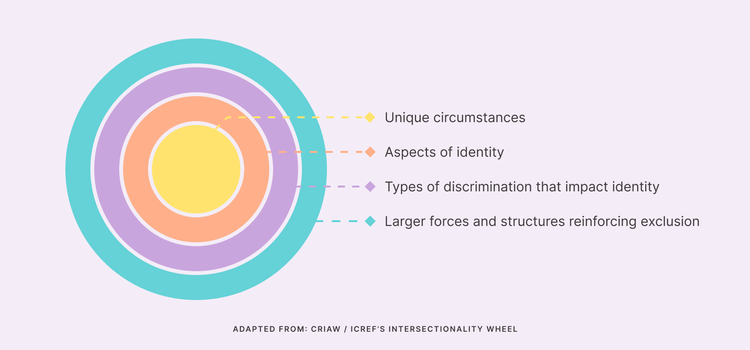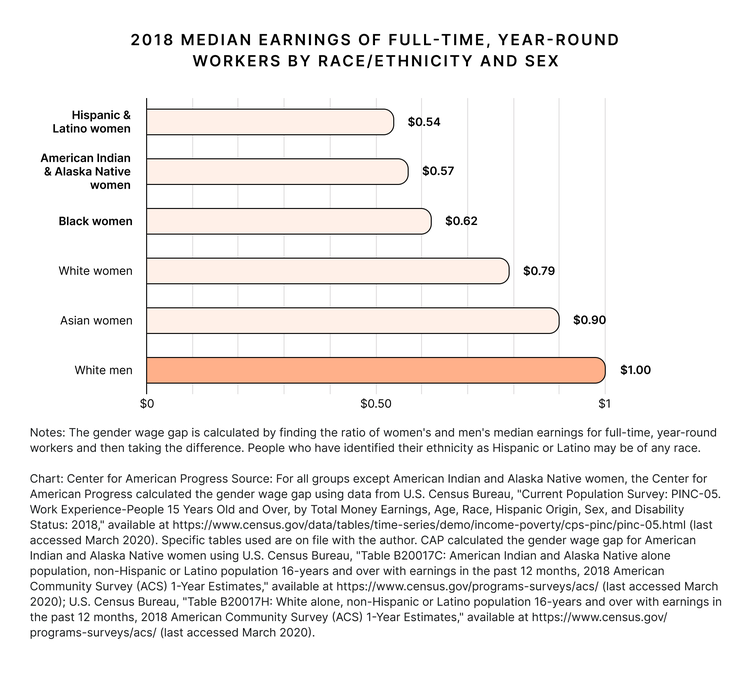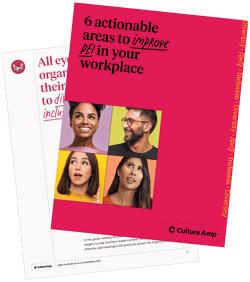
Why intersectionality matters for your organization

Though marginalized people have been dealing with different forms of discrimination and oppression for decades, the concept of intersectionality didn’t become a mainstream idea until 2015. It was then that an official definition of intersectionality was recognized. Nowadays, we define intersectionality is as:
The complex, cumulative way in which the effects of multiple forms of discrimination (such as racism, sexism, and classism) combine, overlap, or intersect especially in the experiences of marginalized individuals or groups.
The better we understand these intersections, the more equipped we are to mitigate oppressive power structures and create a more diverse, equitable, and inclusive workplace for our peers. Below, we take a closer look at intersectionality’s origins, how it has evolved to fit our modern world, and why intersectionality matters for your organization.
Defining and understanding intersectionality
Over 30 years ago, Kimberlé Crenshaw, a lawyer, activist, professor, and scholar of critical race theory, coined the term: “intersectionality.” She was working with a group of legal scholars who spent their careers studying all the ways a person’s different identities could come together to affect them – traditionally negatively – within the justice system. They believed that the system was not just inherently biased but built to be so. In 1989, Crenshaw laid out her theory of intersectionality, “Demarginalizing the Intersection of Race and Sex,” at the University of Chicago Legal Forum.
To simplify her points, Crenshaw claimed that the legal system was designed to work in favor of certain demographics and against, well, the rest of them. She argued a system built to benefit specific individuals - primarily white, wealthy men - is biased against people of color, women, and poor people. Thus, while the system disadvantages all women and people of color, a woman of color, for example, has the cards doubly stacked against her. Addressing a Black woman as either Black or a woman (and not both) doesn’t do enough to recognize her whole and holistic experience as a Black woman.

The CRIAW / ICREF Intersectionality Wheel is extremely useful for understanding the different intersections and how our current power structures reinforce various forms of discrimination. It explains that certain facets make up every person’s identity, including:
- How they grew up (who their parents are, what opportunities they had, etc.)
- Certain changeable and unchangeable factors, such as skin color, sexuality, and education level
- The various types of discrimination one experiences due to those factors such as racism, sexism, or ableism
- Structural issues that perpetuate systems of oppression, such as war or politics
Though every person’s experience is unique, this wheel helps us pinpoint which identities and experiences shape our personal worldviews.
How intersectionality fits into our modern world
The theory of intersectionality was founded on the intersection of race, gender, and class. But as our culture has evolved, our various identities have evolved.
During the 2017 Women’s March, the term and definition of “intersectionality” became widely adopted. It’s now commonly used outside the courtroom to explain the experiences of folks with various overlapping marginalized identities across different spaces, such as the classroom or workplace.
When we think about intersectional identities, race, gender identity, sexual orientation, socioeconomic status, and physical ability are the ones that most often come to mind. But there are plenty of other identity categories that should be considered as well, such as:
- Age
- Religion
- Education level
- Invisible disabilities
- Physical health
- Fertility
- Mental health
- Gender expression
- Language
- Marital status
- Nationality
- Political identity
- Immigration status
All of these factors, and more, contribute to unique perspectives that shift from person to person, creating unique power structures of privilege and oppression.
The way we approach intersectionality in the workplace is crucial to understanding how the employee experience can differ within an organization due to various structures and systems of power. The idea that race and gender are constantly affected by outside social factors, such as class or sexual orientation, means certain employees are potentially affected by discrimination, marginalization, and oppression in ways that go beyond just gender or race.
How overlooking intersectionality can hurt your employees
It’s easy for HR representatives to get bogged down in best DEI practices and pigeonhole employees into specific singular demographics. However, such one-dimensional approaches hurt employees and the organization, undermining the very things DEI is intended to accomplish.
For example, data has shown that while all women are paid less than their male counterparts for the same job, Latinx and Black women are paid even less than white women for the same role.

Without accounting for both experiences, we’d be relying on data for just women or just people of color, but not both. And it’s essential to account for both since you have no way of knowing what aspect of a person’s identity is more affected by institutional biases within your organization.
For example, Catalyst interviewed nearly 1,600 women in various corporate and non-corporate settings. Participants included those who identified as Asian, African-American, Latinx, or a combination of any of those. The study found that while almost 58% of women said they were highly on guard at work, women of color reported feeling slightly more worried about racial bias than sexism at work.
Further, not accounting for how systemic racism, sexism, and ableism can contribute to a person’s experience in the workplace can leave employees feeling unsafe. This sense of unease and exclusion has been characterized as an emotional tax marginalized folks pay when they prepare to deal with potential biases or discrimination. Such toxic workplace cultures can understandably lead to burnout and turnover within your teams.
The New York Times reports on that same study:
“Being on guard manifests itself in different ways, often as repressing perceived traits that play into the stereotype of being frightening or intimidating or just ‘too much.’
...
[Some black] men talked about making sure they arrived at meetings early so they could be seated when others arrived to appear less threatening.”
The bottom line is: If you want to retain your people and help them feel safe, you must anticipate how different folks experience oppression and mitigate these issues with the power of your organization behind you.
Protecting your employees at work
Discrimination can present itself in many subtle ways, such as biased hiring practices, discriminatory healthcare plans, and exclusionary technology requirements. Employees can’t bring their whole selves to work if their company doesn’t recognize their holistic experiences and support their intersectional identities with safe, inclusive practices.
Spend some time examining your diversity, equity, and inclusion practices to ensure that they meet your employees at all the places their identities intersect and provide them with the comfortable working conditions those identities need to feel safe and supported. Your organization will be better off for it, and your workforce will be further along the path to a better world of work.





